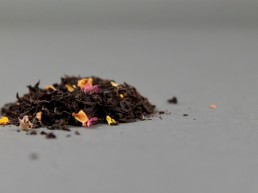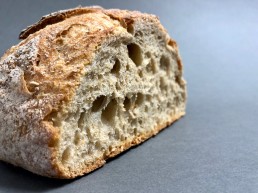Everybody knows how to cook pasta. Don't they?
Most of us grew up eating pasta. It’s a familiar British staple. You know, like other British staples such as olive oil, panettone and cappuccino. From Italy.
Now you might already be thinking a ‘How to cook pasta’ article is for dunces. And you’d be right. The thing is, I was one of those dunces and I hate to break it to you, but you might be too.
I’ve been cooking pasta since I was a teenager and had always thought I did a pretty decent job but as I’ve gotten older and more interested in food I’ve realised I, like many people, have been making a complete hash of it without even realising. Even If you think you’ve mastered spaghetti and perfected penne, take a look at the tips below. You might be surprised.
1. Use a gigantic saucepan and loads of water.
Pasta releases a lot of starch (glue to you and me) when it cooks. If there’s not enough water for the starch to escape into and not enough room in your cooking pot, it will simply stick to your pasta instead. Use the biggest pot you have and use as much water as the pot will comfortably hold. In an ideal world you’re looking at approximately 1 litre of water per 100g of dry pasta.
Extra tip: a pan with a lid is a bonus as once you add your pasta to the water you can whack the lid on to bring it back to the boil quicker.
2. Bring your water to a rollicking boil before adding your pasta
A big temptation is to pop your pasta into an empty saucepan, fill it with cold water and then go take 20 selfies while it comes to the boil. Bad idea! This just soaks your pasta without actually cooking it and will give you a slimy meal. Instead, bring that comedy-sized saucepan of water to a rollicking boil BEFORE you add the pasta.
3. There’s no need to add oil
A lot of people recommend adding oil to your cooking water to stop pasta from sticking together. With the exception of blanching lasagne sheets, this does nothing and if you follow point 1 above, your pasta shouldn’t stick together anyway.
4. Add salt
Adding a bit of salt to the cooking water makes a huge difference to the overall taste of your pasta. You don’t have to go crazy with it, but don’t be scared of adding some.
5. Knock 2 minutes off the cooking time
Sure it’s fun to wing it when cooking, you’re a free spirit and I respect that but when it comes to pasta its worth following the cooking times suggested on the packet. Set a timer for at least 2 minutes less than the quoted time as a lot of pasta cooks quicker than the label claims. Check even sooner if you like your pasta al dente.
6. Give it a stir
Pasta isn’t a particularly demanding food to cook but it does need a stir every few minutes to help prevent it from sticking together; especially long ‘strandy’ pasta shapes like spaghetti or tagliatelle. Using a fork to do your stirring helps even more.
7. Keep a bit of the starchy water
By now the starch in your pasta likely feels like your arch nemesis but it does have its uses. Before pouring it all down the sink when you drain your pasta, syphon off about half a cup. Adding a bit of this starchy water to your pasta sauce can help give it a bit of gloss, especially if it’s a bit too dry or thick.
Cooking gluten-free pasta
Most traditional pastas are made from durum wheat as it’s not too starchy. If you’re cooking gluten free pasta however I’m afraid it’s all too easy to end up in wallpaper paste territory as a lot of gluten free pastas are made from starch-heavy corn and rice blends. I’ve been cooking gluten-free pasta for years so here are a few pointers:
Use a shite load of water. And I do mean a shite load.
As there’s usually a lot more starch in gluten free pasta that starch will need somewhere to go so make sure you use the largest saucepan you own and fill it with as much water as it will comfortably hold. The entire contents of your local reservoir ought to do it. The larger the pan and quantity of water, the less likely you are to be serving your pasta by the slice!
If you need to cook a larger amount of gluten-free pasta then it might be worth splitting it between 2 pots to avoid starch overload.
Go for a blended free-from pasta
Some free-from pastas are made from a single flour like rice or corn. These are generally harder to cook in my experience as they’re incredibly starchy. Thankfully most free from pasta is made from blends of different flours like rice, corn, quinoa and millet which helps tame the glueyness so I’d opt for these instead.
Avoid boiling fresh gluten-free pasta too vigorously
Gluten-free pasta has improved a lot over the years and there are now some pretty decent fresh varieties available. While I always follow the packet instructions in the first instance I’ve actually found that vigorously boiling fresh gluten-free pasta tends to destroy it. Not surprising given the lack of gluten to help hold it together! Instead, try simmering the pasta but stir it frequently and gently. …remember this only works if you follow point one above and use loads of water and a big pan.
Ignore the cooking instructions on gluten-free tortelloni
I always assumed the people who actually make gluten-free pasta know how to cook it better than I do. Turns out I was wrong. Fresh, gluten-free tortelloni is incredibly delicate and just can’t cope with being flung around in a pan of boiling water; even if it is only for 60 seconds. Instead, fill your pan with (lots of) freshly boiled water from the kettle, add salt, and carefully slide your tortelloni into it. Then, very gently stir it several times over the course of the cooking time quoted on the packet. Carefully drain and serve. No need to switch your hob on.













